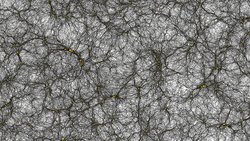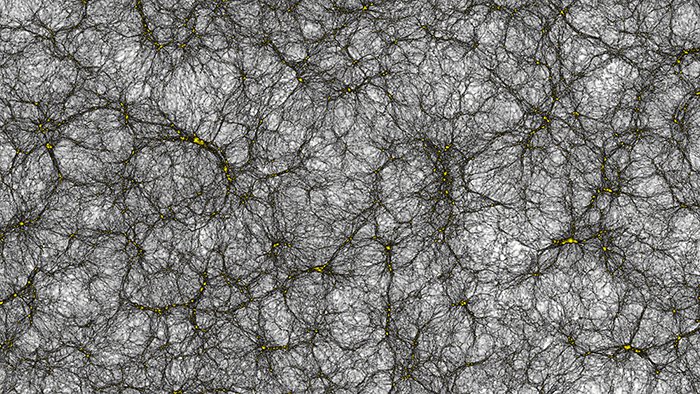
June 13, 2017
By: Michael Feldman
Researchers at the University of Zurich have devised software that is able to simulate the entire universe, employing the two fastest GPU-powered supercomputers in the world.
 Simulation, with dark matter halos shown as yellow clumps. Credit: Joachim Stadel, University of Zurich
Simulation, with dark matter halos shown as yellow clumps. Credit: Joachim Stadel, University of Zurich
Using a code known as PKDGRAV3, the researchers were able to run a two-trillion particle cosmological simulation on Piz Daint, the 16-petaflop supercomputer installed at CSCS in Switzerland, and an eight-trillion particle simulation on Titan, a 27-teraflop machine housed at Oak Ridge National Lab.
According to the researchers, two trillion particles is the minimum needed for galaxy surveys that account for dark matter and dark energy – mysterious components currently under intense scrutiny by cosmologists. The current thinking is that dark matter and dark energy comprise approximately 95 percent of the Universe, with the other 5 percent attributed to what we can actually see. “The cosmological experiments of the next decade might shed light on this ‘dark sector’ and possibly revolutionize modern physics,” write the researchers.
The two-billion particle run on Piz Daint is being characterized as “the largest virtual universe ever simulated. The code was modified to use a reduced memory footprint and leverage the GPUs to the greatest extent possible. The simulation ran across more than 4,000 of the Piz Daint’s nodes, requiring just 80 hours to deliver the map the entire universe.
Titan’s much larger memory and greater system size enabled the researchers to run an eight-trillion particle simulation across its 18,000 nodes in about 67 hours, achieving a peak performance of 10 petaflops. It’s the first such particle simulation executed at this scale, according to the Zurich researchers.
The galaxy catalogue generated by the simulations will be used to guide the experiments that will be performed by the Euclid satellite, which will attempt to map the dark universe during its six-year mission, starting in 2020. The hope is that the data collected by Euclid will provide new information on the nature of dark energy, and perhaps reveal a new aspect of the theory of general relativity, or even lead to the discovery of a new particle. The effort will also trace the evolution of the universe back in time more than 10 billion years.
If you’re interested in the algorithmic details of the PKDGRAV3 code and how the researchers were able to leverage the GPU hardware on Titan and Piz Daint, be sure to check out their research paper published in Computational Astrophysics and Cosmology.
